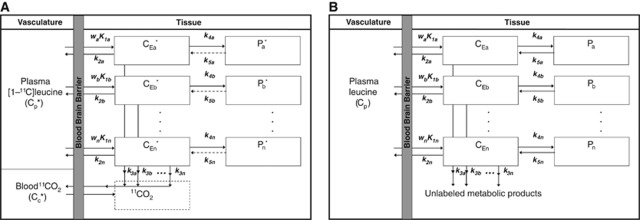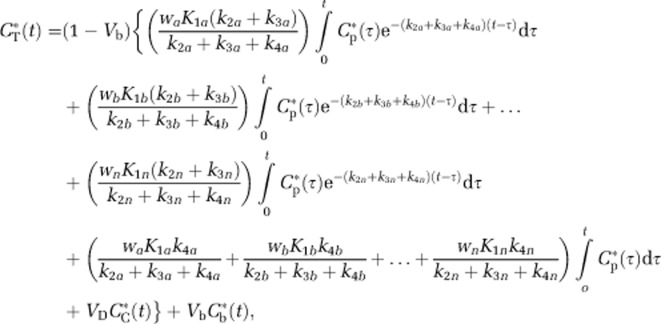Figure 1.
(A) Heterogeneous tissue model for L-[1-11C]leucine. The heterogeneous tissue is composed of n kinetically homogeneous subregions. The constants wa, wb, …, wn represent relative tissue weights of the subregions, where wa+wb+…+wn=1. In each subregion i, K1i and k2i are the rate constants for transport of leucine from plasma to tissue and back, respectively. k3i is the rate constant for the first two steps in leucine catabolism, transamination, and decarboxylation, which yield 11CO2. k4i and k5i are the rate constants for leucine incorporation into protein and for the release of free leucine from proteolysis, respectively. Because of the long half-life of protein in the brain (Lajtha et al, 1976), it is assumed that there is no significant breakdown of labeled product (Pi*) during the experimental interval, that is, k5iPi*∼0. Under the assumptions of negligible fixation of 11CO2 during the experimental period (Siesjo and Thompson, 1965) and rapid equilibration of 11CO2 between the brain and blood (Buxton et al, 1987), the model for each subregion reduces to two-tissue compartments (free L-[1-11C]leucine, CEi*, and L-[1-11C]leucine incorporated into tissue protein, Pi*) plus the 11CO2 compartment in which the concentration is assumed known. In each subregion, the kinetics of leucine are described by the homogeneous tissue model given in Schmidt et al (2005), which assumes that the concentrations of amino acids, rates of blood flow, rates of transport and metabolism of amino acids, and rates of leucine incorporation into protein do not vary within the subregion. Total tracer activity  in the volume is given by
in the volume is given by
where Vb is the fraction of the volume occupied by blood; Cb* is the total 11C concentration in whole blood; VD is the brain:blood equilibrium distribution volume of 11CO2; and Cc* is the 11CO2 concentration in whole blood. VD is fixed at 0.41 (Smith et al, 2005; Brooks et al, 1984). (B) Heterogeneous tissue model for unlabeled leucine. The model used to describe labeled leucine (A) also holds for unlabeled leucine. Assuming no isotope effect, rate constants for labeled and unlabeled leucine are identical. The model for unlabeled leucine in heterogeneous tissue is composed of n homogeneous subregions; in each homogeneous tissue the unlabeled leucine (CEi) and protein (Pi) are assumed to be in steady state, and the steady-state breakdown unlabeled protein (k5iPi) is greater than zero. Therefore, the weighted average of regional rate of cerebral protein synthesis (rCPS) is
where Cp is the concentration of unlabeled leucine in arterial plasma and the rate constants are defined above (Schmidt et al, 2005; Veronese et al, 2010a). The fraction of unlabeled leucine in the precursor pool for protein synthesis in subregion i that is derived from arterial plasma, λi, can be expressed as
and the weighted average influx rate constant for the mixed tissue, K1, as




